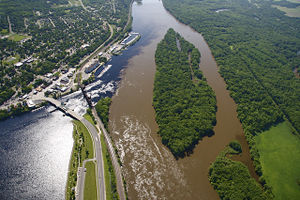
Difference between revisions of "Total Maximum Daily Loads (TMDLs)"
| Line 68: | Line 68: | ||
--> | --> | ||
<!-- | <!-- | ||
| − | |||
--> | --> | ||
*[[Guidance for developing TMDL implementation plans for MS4 stormwater]] | *[[Guidance for developing TMDL implementation plans for MS4 stormwater]] | ||
| Line 83: | Line 82: | ||
**The TMDL Process as it Relates to Stormwater - [[File:Wq-strm7-83a.pdf]] | **The TMDL Process as it Relates to Stormwater - [[File:Wq-strm7-83a.pdf]] | ||
**TMDL Stormwater Language - [[File:Wq-strm7-84a.pdf]] | **TMDL Stormwater Language - [[File:Wq-strm7-84a.pdf]] | ||
| − | **Setting Wasteload | + | **Setting Wasteload Allocations in a TMDL - [[File:Wq-strm7-84b.pdf]] |
| − | |||
**Meeting Requirements of a TMDL - [[File:Wq-strm7-85a.pdf]] | **Meeting Requirements of a TMDL - [[File:Wq-strm7-85a.pdf]] | ||
Revision as of 18:49, 26 July 2022
Total Maximum Daily Loads (TMDLs) are EPA approved amounts of pollutant loading that can occur and have a water body meet water quality standards. This page is collection of links and resources to better understand, and meet, TMDL requirements.
Contents
TMDL MS4 permit guidance
- Forms, guidance, and resources for completing the TMDL annual report form
- Link to many TMDL GIS shapefiles
- Summary of TMDL requirements in stormwater permits
- Guidance for meeting chloride TMDL MS4 permit requirements
- Guidance for meeting bacteria TMDL MS4 permit requirements
- Guidance for meeting dissolved oxygen or oxygen demand TMDL MS4 permit requirements
- Guidance for meeting temperature TMDL MS4 permit requirements
- Guidance for categorical TMDLs
- List of Approved TMDLs with MS4 WLAs
- Guidance for completing the MS4 Permit TMDL Application Form
- MS4 webinars and videos
- Baseline year
- Interpreting wasteload allocations based on flow/load duration curves
TMDL toolkit for MS4 permit compliance

Access a quick guide for using models to meet MS4 TMDL requirements
- Overview of models used to meet MS4 TMDL permit requirements
- P8
- Recommendations and guidance for utilizing P8 to meet TMDL permit requirements
- Case study for using P8 to meet TMDL permit requirements
- U of MN P8 training on the use of the P8 software. P8 is a free software package for modeling stormwater pollutant management in urban watersheds. This training will be offered online through zoom in the afternoons of March 2 and March 3, with a short session on February 23 to confirm software installation and access. For more information on this training, go to this link.
- WINSLAMM
- MIDS (Minimal Impact Design Standards calculator)
- MPCA Simple Estimator
- Recommendations and guidance for utilizing the MPCA Simple Estimator to meet TMDL permit requirements
- Guidance and examples for using the MPCA Estimator
- Case study for using the MPCA Simple Estimator to meet TMDL permit requirements
- MPCA review of submittals using the MPCA Simple Estimator
- Default TSS and TP loads for different land use scenarios using the MPCA Simple Estimator
- Monitoring
- Recommendations and guidance for utilizing monitoring to meet TMDL permit requirements
- Recommendations and guidance for utilizing lake monitoring to meet TMDL permit requirements
- Recommendations and guidance for utilizing stream monitoring to meet TMDL permit requirements
- Recommendations and guidance for utilizing major stormwater outfall monitoring to meet TMDL permit requirements
- Recommendations and guidance for utilizing stormwater best management practice monitoring to meet TMDL permit requirements
- Quick guides for using models to meet MS4 TMDL permit requirements
- Case studies for monitoring to meet TMDL permit requirements
TMDL guidance and general information
- Overview of TMDLs
- Technical guidance used by MPCA to develop guidelines for setting TMDL WLAs for regulated stormwater
- Guidance on what discharges should be included in the TMDL wasteload allocation for MS4 stormwater
- Guidance for developing TMDL implementation plans for MS4 stormwater
- Construction activity by county
- Training modules
- Overview of Stormwater Effects on Water Quality - File:Wq-strm7-81.pdf
- Construction, Industrial & Municipal Stormwater Permits & SWPPPs - File:Wq-strm7-82.pdf
- The TMDL Process as it Relates to Stormwater - File:Wq-strm7-83a.pdf
- TMDL Stormwater Language - File:Wq-strm7-84a.pdf
- Setting Wasteload Allocations in a TMDL - File:Wq-strm7-84b.pdf
- Meeting Requirements of a TMDL - File:Wq-strm7-85a.pdf
Information received from MS4 permittees
Links and other resources
- Visit the MPCA TMDL Project page for information on specific projects across the state
- Total Suspended Solids (TSS)
- Phosphorus
- Bacteria in stormwater
- Protection and restoration of receiving waters
